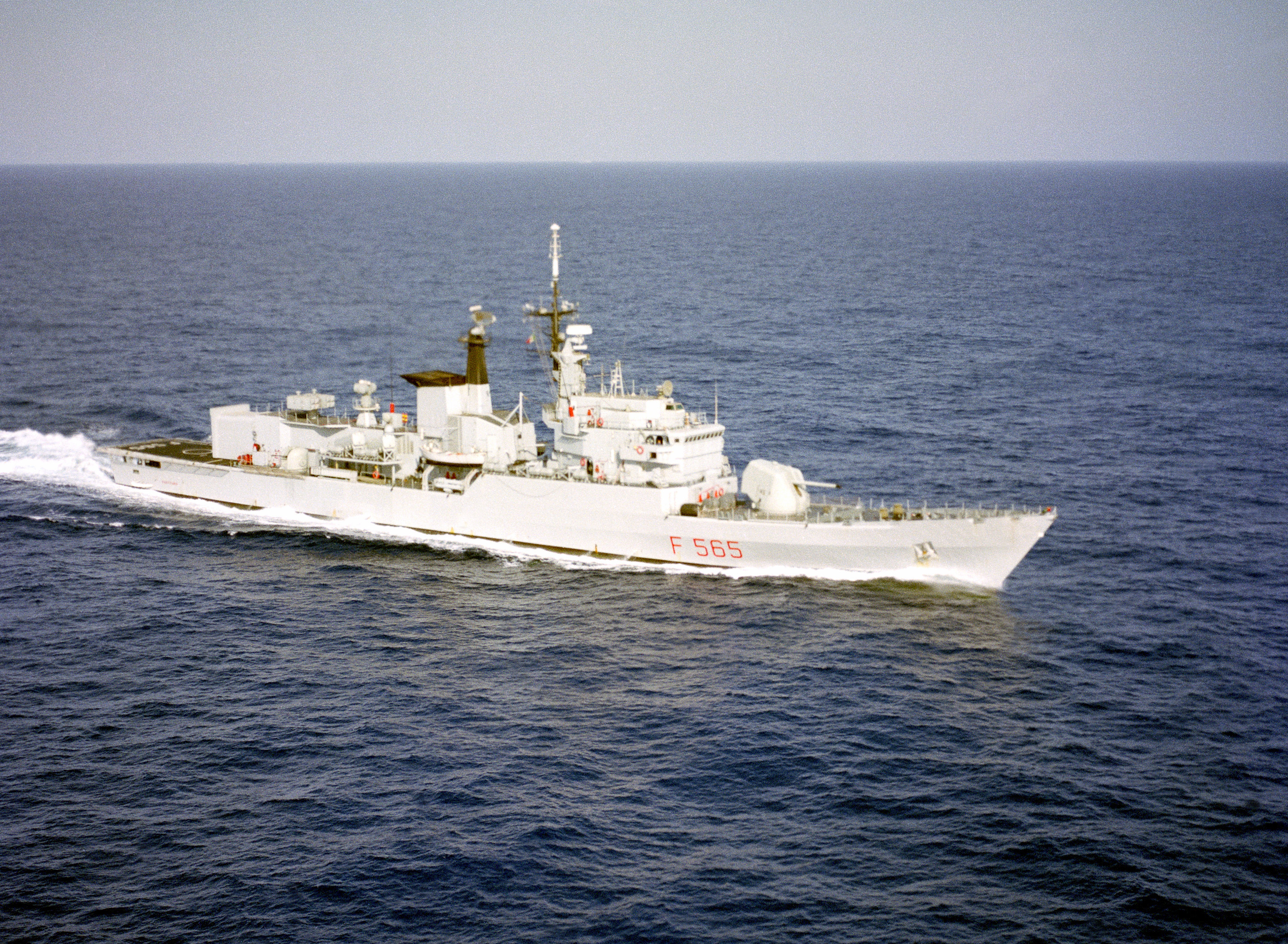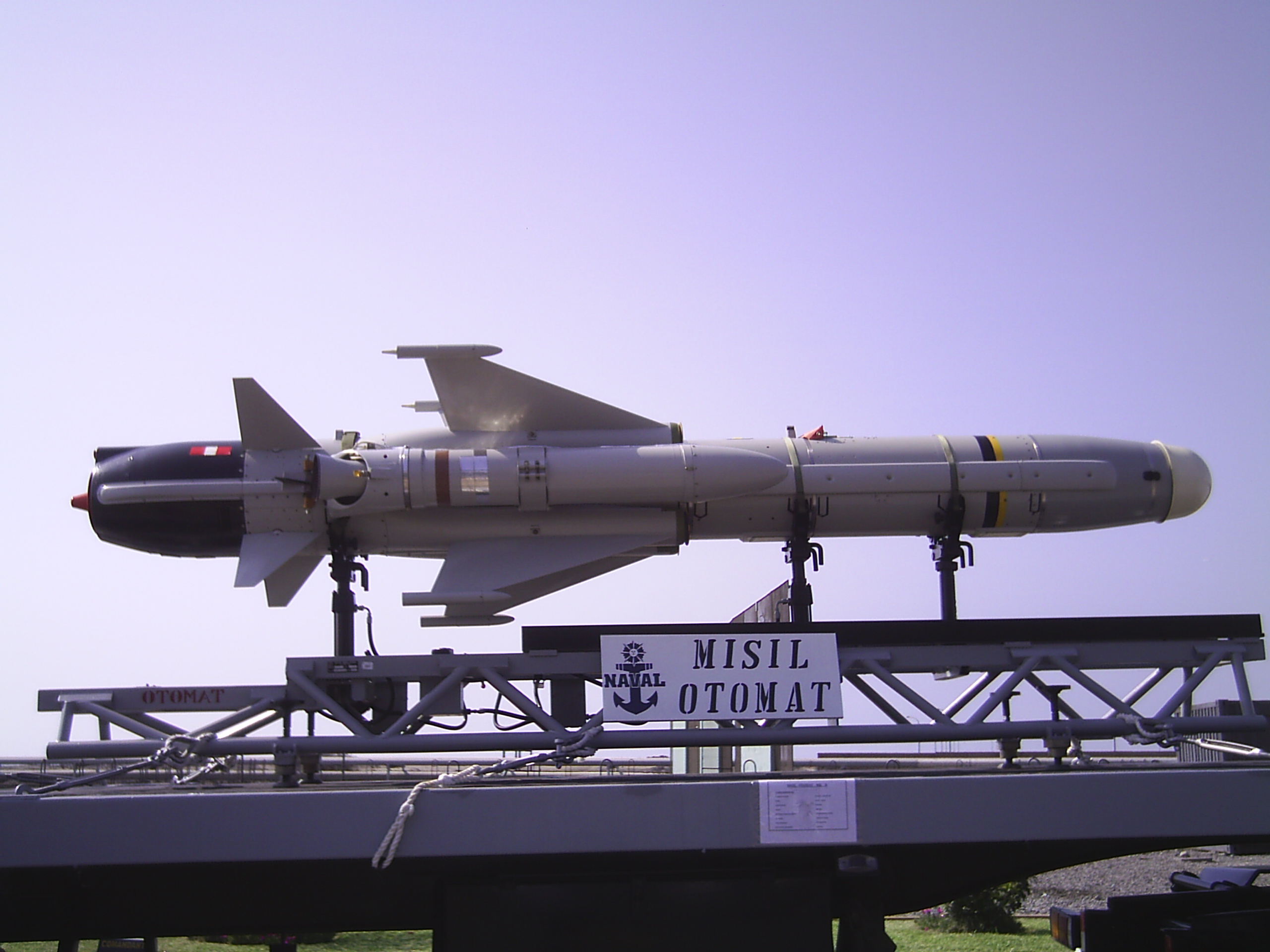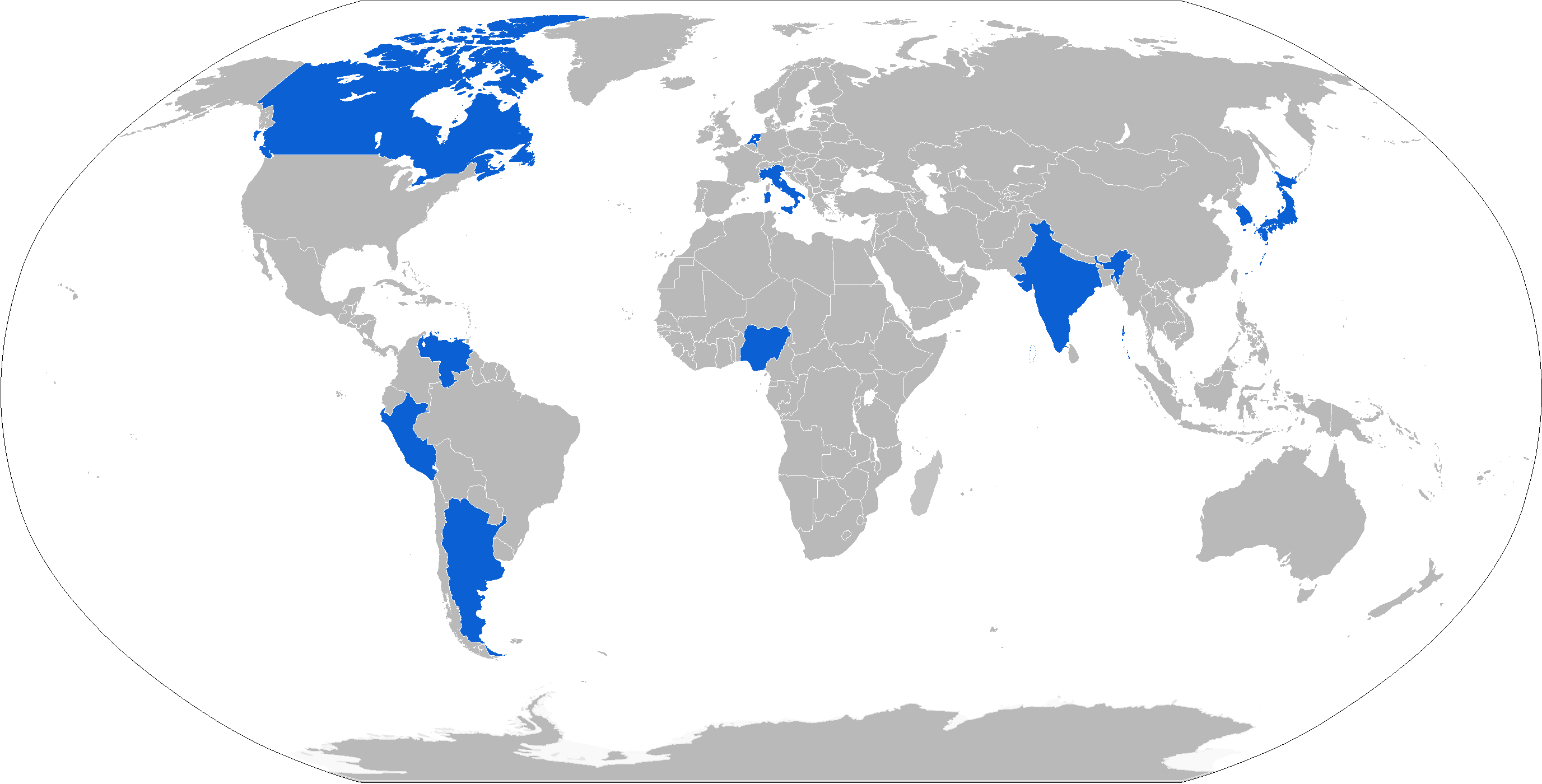|
Lupo Class Frigate
The ''Lupo'' class is a class of frigates built by ''Cantieri Navali Riuniti'' (CNR) for the Italian Navy. Designed as multipurpose warships with an emphasis on anti-surface warfare (ASuW), they have enjoyed some success in the export market, being acquired by the navies of Peru and Venezuela. A small run of a slightly updated version is known as the Soldati class. Design In the early 1970s, the Italian Navy faced an increased Soviet naval presence in the Mediterranean Sea which constituted a threat to its sea lines of communication as well as to its extensive coastline. To parry this menace, Italy started a naval expansion program which included frigates focused on ASuW (''Lupo'' class) and on ASW (). For the first part of the requirement, CNR presented a design for a 2,500-ton frigate with a high speed and a heavy weapons load. The ship employed a CODOG propulsion plant to achieve 35 knots, making it one of the fastest warships at the time. Armament included 8 SSMs, ... [...More Info...] [...Related Items...] OR: [Wikipedia] [Google] [Baidu] |
Peruvian Navy
The Peruvian Navy ( es, link=no, Marina de Guerra del Perú, abbreviated MGP) is the branch of the Peruvian Armed Forces tasked with surveillance, patrol and defense on lakes, rivers and the Pacific Ocean up to from the Peruvian littoral. Additional missions include assistance in safeguarding internal security, conducting disaster relief operations and participating in international peacekeeping operations. The ''Marina de Guerra del Perú'' celebrates the anniversary of its creation in 1821 on October 8 and also commemorates the decisive Battle of Angamos, the final part of the naval campaign of the War of the Pacific between Peru and Chile at the end of 1879. History 19th century The ''Marina de Guerra del Perú'' was established on 8 October 1821 by the government of general José de San Martín. Its first actions were undertaken during the War of Independence (1821–1824) using captured Spanish warships. The Peruvian Naval Infantry was also formed during the war with Spai ... [...More Info...] [...Related Items...] OR: [Wikipedia] [Google] [Baidu] |
Otomat
The Otomat is an anti-ship and coastal defence missile developed by the Italian company Oto Melara jointly with Matra and now made by MBDA. The name comes, for the first versions, from the name of the two builders ("Oto Melara" and "Matra") and, for the later versions, Teseo, from the Italian word for Theseus. The MILAS variant is an anti-submarine missile. In its latest version Mk/2E purchased by the Italian Navy is a medium range anti-ship missile and a ground attack missile. Origins The Otomat missile program started in 1967, the same year in which the Israeli destroyer ''Eilat'' was sunk by three Soviet-made P-15 Termit anti-ship missiles. This event raised awareness about the effectiveness of such weapons and prompted the development of similar systems in Western countries, such as the Harpoon in the United States. However, it is unknown whether the Otomat program started before or after the Eilat event. The Otomat program was undertaken by the Italian Oto Melara corporat ... [...More Info...] [...Related Items...] OR: [Wikipedia] [Google] [Baidu] |
Italian Navy
"Fatherland and Honour" , patron = , colors = , colors_label = , march = ( is the return of soldiers to their barrack, or sailors to their ship after a leave) by Tommaso Mario , mascot = , equipment = , equipment_label = , battles = , anniversaries = 10 June – Sinking of the Austro-Hungarian battleship ''SMS Szent István'' by Luigi Rizzo , decorations = 1 Cavalier Cross of the Military Order of Savoy 3 Cavalier's Crosses of the Military Order of Italy 2 Gold Medals of Military Valor 1 Silver Medal of Military Valor 1 Gold Medal for Merited Public Honor , battle_honours = , commander1 = ammiraglio di squadra Enrico Credendino , commander1_label = Chief of Staff of the Italian Navy , commander2 ... [...More Info...] [...Related Items...] OR: [Wikipedia] [Google] [Baidu] |
Frigate
A frigate () is a type of warship. In different eras, the roles and capabilities of ships classified as frigates have varied somewhat. The name frigate in the 17th to early 18th centuries was given to any full-rigged ship built for speed and maneuverability, intended to be used in scouting, escort and patrol roles. The term was applied loosely to ships varying greatly in design. In the second quarter of the 18th century, the 'true frigate' was developed in France. This type of vessel was characterised by possessing only one armed deck, with an unarmed deck below it used for berthing the crew. Late in the 19th century (British and French prototypes were constructed in 1858), armoured frigates were developed as powerful ironclad warships, the term frigate was used because of their single gun deck. Later developments in ironclad ships rendered the frigate designation obsolete and the term fell out of favour. During the Second World War the name 'frigate' was reintroduced to des ... [...More Info...] [...Related Items...] OR: [Wikipedia] [Google] [Baidu] |
Ship Class
A ship class is a group of ships of a similar design. This is distinct from a ship type, which might reflect a similarity of tonnage or intended use. For example, is a nuclear aircraft carrier (ship type) of the (ship class). In the course of building a class of ships, design changes might be implemented. In such a case, the ships of different design might not be considered of the same class; each variation would either be its own class, or a subclass of the original class (see for an example). If ships are built of a class whose production had been discontinued, a similar distinction might be made. Ships in a class often have names linked by a common factor: e.g. s' names all begin with T (, , ); and s are named after American battles (, , , ). Ships of the same class may be referred to as sister ships. Naval ship class naming conventions Overview The name of a naval ship class is most commonly the name of the lead ship, the first ship commissioned or built of its design. ... [...More Info...] [...Related Items...] OR: [Wikipedia] [Google] [Baidu] |
Helicopter
A helicopter is a type of rotorcraft in which lift and thrust are supplied by horizontally spinning rotors. This allows the helicopter to take off and land vertically, to hover, and to fly forward, backward and laterally. These attributes allow helicopters to be used in congested or isolated areas where fixed-wing aircraft and many forms of STOL (Short TakeOff and Landing) or STOVL (Short TakeOff and Vertical Landing) aircraft cannot perform without a runway. In 1942, the Sikorsky R-4 became the first helicopter to reach full-scale production.Munson 1968.Hirschberg, Michael J. and David K. Dailey"Sikorsky". ''US and Russian Helicopter Development in the 20th Century'', American Helicopter Society, International. 7 July 2000. Although most earlier designs used more than one main rotor, the configuration of a single main rotor accompanied by a vertical anti-torque tail rotor (i.e. unicopter, not to be confused with the single-blade monocopter) has become the most comm ... [...More Info...] [...Related Items...] OR: [Wikipedia] [Google] [Baidu] |
Bell 212
The Bell 212 (also known as the ''Twin Two-Twelve'') is a two-blade, medium helicopter that first flew in 1968. Originally manufactured by Bell Helicopter in Fort Worth, Texas, United States, production was moved to Mirabel, Quebec, Canada in 1988, along with all Bell commercial helicopter production after that plant opened in 1986. The 212 was marketed to civilian operators and has up to a 15-seat capacity, with one pilot and fourteen passengers. In cargo-carrying configuration the 212 has an internal capacity of 220 ft3 (6.23 m3). An external load of up to 5,000 lb (2,268 kg) can be carried. Development Based on the stretched fuselage Bell 205, the Bell 212 was originally developed for the Canadian Forces as the ''CUH-1N'' and later redesignated as the ''CH-135''. The Canadian Forces took delivery of 50 starting in May 1971. At the same time the United States military services ordered 294 Bell 212s under the designation UH-1N. By 1971, the Bell 212 had be ... [...More Info...] [...Related Items...] OR: [Wikipedia] [Google] [Baidu] |
DARDO
Dardo means dart in Italian, Portuguese and Spanish. Dardo may also refer to: * Dardo IFV, an Italian infantry fighting vehicle * DARDO, an Italian close-in weapon system * Dardo (automobile), a Brazilian sports car * Tibetan name for the Chinese city of Kangding *''Dardo-'', combing form of the word ''Dardic'' *Italian destroyer Dardo, two destroyers built for the Regia Marina The ''Regia Marina'' (; ) was the navy of the Kingdom of Italy (''Regno d'Italia'') from 1861 to 1946. In 1946, with the Italian constitutional referendum, 1946, birth of the Italian Republic (''Repubblica Italiana''), the ''Regia Marina'' ch ... * Paul Jason Dardo, American drag queen known as Violet Chachki {{disambiguation ... [...More Info...] [...Related Items...] OR: [Wikipedia] [Google] [Baidu] |
Otobreda 127/54 Compact
The Otobreda 127mm/54 Compact (''127/54C'') gun is a dual purpose naval artillery piece built by the Italian company Oto Melara. It uses the 127mm round which is also used in the 5 inch/ 54 gun, albeit that this gun calibre is measured in United States customary units rather than metric. The gun uses an automatic loading system where 66 127mm rounds of various kinds can be stored ready-to-fire in three loader drums (each holding 22 rounds). The barrel is water-cooled. Currently the gun is still in use by navies around the world but it is slowly being replaced by the Otobreda 127/64 for new vessels, such as the German Navy's F125-class frigate and Italian Navy's FREMM. OTO Melara 127/64 A replacement of the 127/54 compact, Oto Melara started the design in 1992, and completed it in 2003. The new lightweight gun, weighing 17 tons without magazine or ammunition handling, has a rate of fire of 35 rpm, and can fire the long range guided Vulcano ammunition. Operators The Otobr ... [...More Info...] [...Related Items...] OR: [Wikipedia] [Google] [Baidu] |
Oto Melara
OTO Melara was a subsidiary of the Italian company Finmeccanica, today Leonardo, active in the defence sector, with factories in Brescia and La Spezia. The Mod 56 pack howitzer, in service throughout the world, and the 76mm naval gun, adopted by 53 navies and installed on over 1,000 naval vessels, are among OTO Melara's best known weapons since World War II. From 1 January 2016, the activities of OTO Melara merged into Leonardo's Defence Systems Division, within the Electronics, Defence and Security Systems Sector. History Pre–World War I It was founded in 1905 as a joint venture of Vickers and Terni Steelworks, Cantiere navale fratelli Orlando and Cantieri navali Odero. Investment was also provided by Giuseppe Orlando and Attilio Odero. During World War I, Vickers Terni produced many weapons with calibre 40 mm and upwards. In 1929 the company was renamed Odero Terni Orlando with the abbreviation OTO. During World War II, mostly heavy guns for battleships were pro ... [...More Info...] [...Related Items...] OR: [Wikipedia] [Google] [Baidu] |
Mark 32 Surface Vessel Torpedo Tubes
Mark 32 Surface Vessel Torpedo Tubes (Mk 32 SVTT) is a torpedo launching system designed for the United States Navy. History The Mark 32 has been the standard anti-submarine torpedo launching system aboard United States Navy surface vessels since its introduction in 1960, and is in use aboard the warships of several other navies. During the FRAM Program, , and destroyers were modernized and fitted with two Mark 32 torpedo tubes on each side of their midship. The torpedo tubes' service extended to multiple other countries such as Mexico, South Korea, Taiwan, Turkey, Egypt and many more due to the fact that decommissioned American ships were bought or transferred over to them throughout the years, notably s. Japan uses the HOS-301 torpedo tubes which are redesignated version of the Mark 32. Design Most versions (referred to as modifications or mods) are triple-tube sets that can be rotated or trained to face a target. The exception is the Mod 9 sets, which only have two ... [...More Info...] [...Related Items...] OR: [Wikipedia] [Google] [Baidu] |
Surface-to-air Missile
A surface-to-air missile (SAM), also known as a ground-to-air missile (GTAM) or surface-to-air guided weapon (SAGW), is a missile designed to be launched from the ground to destroy aircraft or other missiles. It is one type of anti-aircraft system; in modern armed forces, missiles have replaced most other forms of dedicated anti-aircraft weapons, with anti-aircraft guns pushed into specialized roles. The first attempt at SAM development took place during World War II, but no operational systems were introduced. Further development in the 1940s and 1950s led to operational systems being introduced by most major forces during the second half of the 1950s. Smaller systems, suitable for close-range work, evolved through the 1960s and 1970s, to modern systems that are man-portable. Shipborne systems followed the evolution of land-based models, starting with long-range weapons and steadily evolving toward smaller designs to provide a layered defence. This evolution of design increasin ... [...More Info...] [...Related Items...] OR: [Wikipedia] [Google] [Baidu] |








